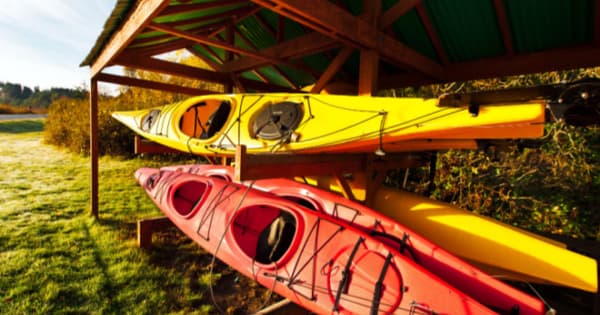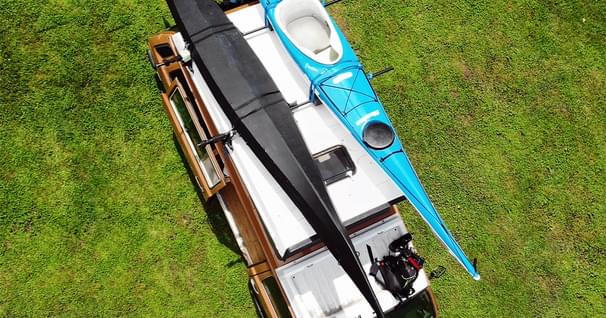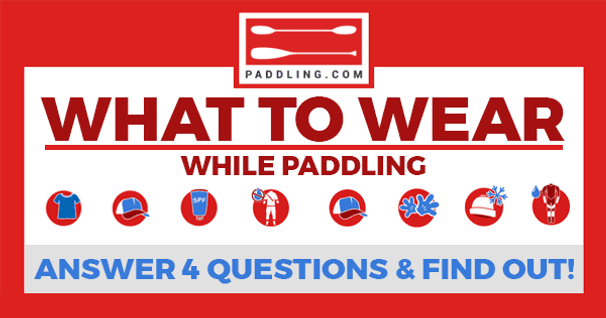How to Store Your Kayak Between Paddling Trips
So, you’ve got your new kayak this season. You figured out how to transport it. Figured out how to pack it with gear. Most importantly, you figured out how to paddle it. Now, what about storing it? Hopefully some of these tips may help when putting your water companion away until the next adventure.

As in many other paddling topics, we can first begin our discussion noting how different kayaks may require completely different approaches for storage. Some are long, some are short. Some are heavy and built like a tank, others are ultra-light and require a gentler approach. At the same time, these decisions will also depend on what is available to us – and where we’ll be able to store them. Outdoors, indoors, garages, basements, closets or sometimes even the trunk of our vehicle.
Let’s begin with some general things to consider. Most of the time, paddlers will store their kayaks on racks that have two contact points – similar to when we transport them on our vehicles. And just like for transport, it’s a good idea to try to pick two structurally strong locations on the kayak for support during storage. For example, on longer sea kayaks, lining up the racks under the bulkheads can provide good support.
It also will help to have plenty of padding between the rack and the kayak, especially if the rack has sharp edges. Some racks will use straps for the kayak to “hang” in place instead of resting on padding, so that the strap will follow the shape of the kayak exactly and reduce the chance of hurting it. Another consideration depending on your type of kayak and rack is to have the kayak rest on its side or upside down, as it may help keep your hull from deforming or getting hurt. Lastly, if you’re storing your kayak for long periods at a time, consider shifting it every so often so it doesn’t sit too long in the same position.
Plastics and Composites
Generally, plastic kayaks may be a bit more forgiving with ways to be stored, especially if it was made to take a lot of abuse on the water. Some whitewater kayaks are essentially tiny tanks. However, as mentioned before, sharp edges, extreme heat, or long periods of time without moving can cause problems for any plastic boat sitting on racks. Composites boats have different characteristics overall – they can be very strong on the water and super light. And while some will be tougher than others, still be mindful to store them using structurally sound spots and racks that will keep them safe.
DIY vs. Pre-made Racks
There’s a lot of pre-made kayak racks, stands and slings already out there. Some are free-standing, others need to be attached to a wall, and there’s even hanging systems to keep your kayak up near the ceiling and out of the way. Pre-made racks don’t have to be the only route to take. If you’re willing and have materials available, a kayak rack can be made at home with pretty much anything – wood, PVC piping, anything that might allow you to have those two points of contact and plenty of foam to ensure it will not damage the kayak.
Examples of Rack Systems
- EZ 3-Boat Free Standing Rack by Suspenz Storage & Transport
- FS Rack™ 3 Kayak Storage Rack by Malone Auto Racks
- Kayak Hanger Sling by Harmony Tie Boss LLC
- Universal Kayak Replacement Foam Blocks by Riverside
EZ 3-Boat Free Standing Rack
The EZ 3-Boat Free-Standing Solution includes Safety Straps! Economical Free-Standing Kayak-Canoe Storage Racks. Boats rest on Canvas Covered foam padding and a powder coated steel frame for indoor and outdoor use. Leveling feet & optional anchoring hardware are included. Protects boats from abrasions, dents and hull distortion. Expand this EZ 3-Boat Free-Standing Rack to hold kayaks on back-side. Reinforced safety straps securely hold your boats in place. Saves storage space by angling the boat and protects hulls at the same time.
Kit includes everything to rack 3 kayaks: 3 Pair of EZ Padded Arms with safety straps & 3-Boat Frame with leveling feet and anchoring hardware
Marine Grade BLACK for use in salt water environments is powder-coated steel with galvanized coating and stainless steel hardware. $544.80
- More information about EZ 3-Boat Free Standing Rack
- View all products from Suspenz Storage & Transport
- Material Description: Powder Coated steel frame
Additional Attributes
- Holds up to 100 lbs. per boat
- Indoor or Outdoor use
- Assembled rack dimensions: Footprint: 24" x 24" per tower Height: 76"
EZ 3-Boat Free Standing Rack Reviews
I got tired of having my…
FS Rack™ 3 Kayak Storage Rack

The MPG318 is a three boat self-standing boat storage rack. Comes complete with frame, hardware, J-Style Holders and lower frame kayak blocks. Built with powder coated high load steel, this package is easy to assemble and will last for years.
- Material Description: Heavy duty 1.25" square tube construction
Additional Attributes
- Three boat capacity
- Heavy duty 1.25" square tube construction
- Powder coated for inside or outside installation
- Six independent adjustable frame levelers
- One set of MPG339 lower frame kayak blocks
- Two sets of MPG320 J-Style padded holders
- Corrosion resistant hardware with installation tool
- Lifetime Limited Warranty
FS Rack™ 3 Kayak Storage Rack Reviews
Kayak Hanger Sling
Kayak Hanger Sling - Universal sling fits any Kayak, Canoe, Paddle Board or Roof Top Carrier. It comes with 2 x 1/4" Tie Boss with 15 feet of rope.
- More information about Kayak Hanger Sling
- View all products from Harmony Tie Boss LLC
Additional Attributes
- Maximum load 150 lbs or 68 kilos
- Easy to install it only requires 2 eye hooks
- Raise, Lower and Store with no Tying off required
- One person operation
Kayak Hanger Sling Reviews
No one has submitted a review yet for the Kayak Hanger Sling. Please help out the community and share your experience!
Universal Kayak Replacement Foam Blocks

Another option is to use the same types of foam blocks you might use on your vehicle to transport the kayak, simply placed on the floor.
Additional Attributes
- Extra tall and slotted to hold kayak
- Includes 2 blocks
Universal Kayak Replacement Foam Blocks Reviews
I have used these foam…
I once re-used an extremely old rack from a broken electronic drum set that I had stored away in a closet for years. I re-configured it to the shape I wanted, added foam throughout, and had a double kayak rack ready to go. Currently, we have a rack we made at home with wood in our garage. The rack is attached to the wall studs for strength and support. The bottom arms rest on the floor just high enough to allow the bottom kayak to sit sideways, and there’s another set of arms above it to hold a second kayak. You can see this particular setup in the video below.
Outdoor Storage
While storing your kayak indoors may be preferable (easier to keep it out of the elements, easier to keep the critters out, etc.), sometimes that’s just not an option. If you must store your kayak outdoors, you can take a couple of steps for extra protection. A cover from the sun will be extremely helpful in keeping UV rays from degrading your kayak, no matter its material – as well as keeping it sheltered from rain and/or snow. If possible, a spot that might remain shady throughout the day can also be a good idea, as it might help in keeping a more constant temperature vs being blasted by the sun for prolonged periods of time. A cockpit cover will also help keeping unwanted visitors from making a home inside your kayak. It’s never a fun surprise to have a creepy crawler say hi by walking on our legs during a paddle…
Folding, Collapsible and Inflatables
The types of kayaks that have the biggest advantage for storage are folding, collapsible and inflatable kayaks. These are designed with storage in mind and allow us to tuck them away almost anywhere – often times paddlers will keep them in their vehicles so they’re always ready for the next adventure. Still, a couple of items to think about when storing these types of kayaks.
Moisture, dirt, and any other element that might hurt your kayak can cause more harm with these styles since they’ll often be stored away packed tight without ventilation. So, before putting them away, make sure to rinse and/or clean them, and give them time to dry – especially if storing them long term. Also consider where it’ll be stored and extreme heat or cold temperatures. If they remain in your vehicle for long periods of time, how will these temperatures affect them long term?
Some Last Items to Consider
- Rinsing and cleaning your kayak before storage – especially if paddling in salt water will help keep them in good shape.
- As mentioned, moisture can be harmful long term so allowing for them to dry before and during storage is a good idea. Maybe consider opening your hatches for a bit to air dry as well if there’s a chance there is water or moisture in there as well.
- Remember to empty out the kayak if there’s a chance items might remain wet while in the hatches. We often keep safety gear inside full time so it’s always there when needed – just make sure all of these items have a chance to dry as well.
Luke Rovner (Kayak Hipster) is a sea kayak instructor, photographer and filmmaker. Combining his experience as a photo and video professional with a love for kayaking, he started Kayak Hipster with the goal of capturing outdoor adventures and sharing kayaking tips.
Related Articles
So, you are finally out on the water and itching to spend more time outdoors – maybe go a bit further…
After lots of research, maybe some classes, maybe some demo days, or maybe after finding the right sale…
For some of us, storing our canoe or kayak is as simple as dropping it off alongside the garage or…
Wondering what to wear when going paddling? Answer 4 quick questions and instantly learn what you need…







